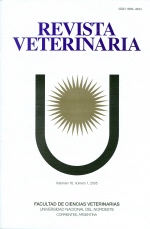Ver ítem
- xmlui.general.dspace_homeCentros e Institutos de InvestigaciónCICVyA. Centro de Investigación en Ciencias Veterinarias y AgronómicasInstituto de VirologíaArtículos científicosxmlui.ArtifactBrowser.ItemViewer.trail
- Inicio
- Centros e Institutos de Investigación
- CICVyA. Centro de Investigación en Ciencias Veterinarias y Agronómicas
- Instituto de Virología
- Artículos científicos
- Ver ítem
Herpesvirus bovino 1 (BoHV-1): actualización de las cepas circulantes en Argentina = Bovine herpesvirus 1 (BoHV-1): update of circulating strains in Argentina
Resumen
BoHV-1 genera en el ganado bovino una amplia gama de manifestaciones clínicas, tales como la rinotraqueítis infecciosa bovina, abortos y vulvovaginitis pustular infecciosa, que dependen de la virulencia del virus y del estado inmunitario del hospedador. En este trabajo se caracterizaron en Argentina 44 aislamientos de BoHV-1 por el análisis de restricción con endonucleasas (REA). El ADN viral fue sometido al clivaje de la enzima HindIII, la cual permite
[ver mas...]
BoHV-1 genera en el ganado bovino una amplia gama de manifestaciones clínicas, tales como la rinotraqueítis infecciosa bovina, abortos y vulvovaginitis pustular infecciosa, que dependen de la virulencia del virus y del estado inmunitario del hospedador. En este trabajo se caracterizaron en Argentina 44 aislamientos de BoHV-1 por el análisis de restricción con endonucleasas (REA). El ADN viral fue sometido al clivaje de la enzima HindIII, la cual permite la diferenciación entre los subtipos 1.1, 1.2a y 1.2b. De acuerdo al perfil REA de los aislamientos, 35 cepas (80%) mostraron un patrón similar a la cepa K22 (prototipo BoHV- 1.2b), 7 cepas (16%) exhibieron un patrón similar a la cepa LA (prototipo BoHV-1.1) y sólo 2 cepas (4%) revelaron un patrón similar a la cepa ST (prototipo BoHV-1.2a). Los resultados
demuestran una mayor prevalencia del subtipo 1.2b entre los aislamientos BoHV-1 argentinos.
Además, se reporta por primera vez en Argentina, la circulación del subtipo BoHV-1.2a.
BoHV-1 in cattle results in a wide range of clinical manifestations, such as infectious bovine rhinotracheitis, abortion and infectious pustular vulvovaginitis, depending on the virulence of the virus and the immune status of the host. Forty-four Argentinean BoHV1 isolates were characterized by restriction endonuclease analysis (REA). Viral DNA was cleaved with HindIII which allows the differentiation among subtypes 1.1, 1.2a and 1.2b. According to the REA, 35 field strains (80%) showed a pattern similar to K22 strain (BoHV-1.2b prototype), 7 field strains (16%) showed a clear pattern similar to LA strain (BoHV-1.1 prototype) and only 2 filed strains (4%) showed a clear pattern similar to ST strain (BoHV-1.2a prototype).
The results demonstrated the presence of a marked prevalence of subtype 1.2b among Argentinean BoHV-1 isolates. We also report for the first time in Argentina the circulation of the subtype BoHV-1.2a.
[Cerrar]
BoHV-1 in cattle results in a wide range of clinical manifestations, such as infectious bovine rhinotracheitis, abortion and infectious pustular vulvovaginitis, depending on the virulence of the virus and the immune status of the host. Forty-four Argentinean BoHV1 isolates were characterized by restriction endonuclease analysis (REA). Viral DNA was cleaved with HindIII which allows the differentiation among subtypes 1.1, 1.2a and 1.2b. According to the
[ver mas...]
BoHV-1 in cattle results in a wide range of clinical manifestations, such as infectious bovine rhinotracheitis, abortion and infectious pustular vulvovaginitis, depending on the virulence of the virus and the immune status of the host. Forty-four Argentinean BoHV1 isolates were characterized by restriction endonuclease analysis (REA). Viral DNA was cleaved with HindIII which allows the differentiation among subtypes 1.1, 1.2a and 1.2b. According to the REA, 35 field strains (80%) showed a pattern similar to K22 strain (BoHV-1.2b prototype),
7 field strains (16%) showed a clear pattern similar to LA strain (BoHV-1.1 prototype) and only 2 filed strains (4%) showed a clear pattern similar to ST strain (BoHV-1.2a prototype). The results demonstrated the presence of a marked prevalence of subtype 1.2b among Argentinean BoHV-1 isolates. We also report for the first time in Argentina the circulation of the subtype BoHV-1.2a.
[Cerrar]

Autor
Fuente
Revista veterinaria / Universidad Nacional del Nordeste 29 (1) : 52-56 (Junio 2018)
Fecha
2018-06
Editorial
Universidad Nacional del Nordeste
ISSN
1669-6840
Formato
pdf
Tipo de documento
artículo
Palabras Claves
Derechos de acceso
Abierto
 Excepto donde se diga explicitamente, este item se publica bajo la siguiente descripción: Creative Commons Attribution-NonCommercial-ShareAlike 2.5 Unported (CC BY-NC-SA 2.5)
Excepto donde se diga explicitamente, este item se publica bajo la siguiente descripción: Creative Commons Attribution-NonCommercial-ShareAlike 2.5 Unported (CC BY-NC-SA 2.5)


